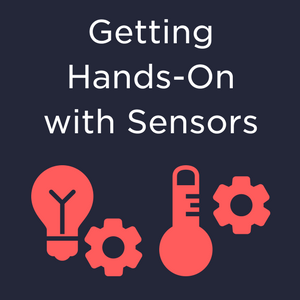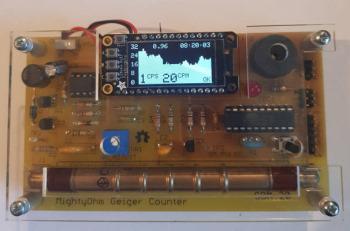CT433-HSWF70MR TMR Current Sensor Compact Carrier -70A to +70A, 3.3V
Available with a lead time
Expect dispatch between Apr 02 and Apr 07
Quantity Discounts:
- 10+ $14.96 (exc GST)
- 25+ $14.50 (exc GST)
 |
 |
| CT432/CT433 TMR Current Sensor Compact Carrier (top) and Large Carrier (bottom) size comparison. |
|---|
Pololu are offering these breakout boards with support from Allegro Microsystems as an easy way to use or evaluate their CT432/CT433 tunneling magnetoresistance (TMR), electrically isolated, high-bandwidth current sensors that are optimized for high dV/dt applications; Pololu therefore recommend careful reading of the applicable CT432 datasheet or CT433 datasheet before using this product. The following list details some of the sensors’ key features:
- CT432/CT433 sensors use Allegro’s patented XtremeSense™ TMR (tunneling magnetoresistance) technology for high accuracy, high bandwidth, electrically isolated current measurements.
- Sensor can be inserted anywhere along the current path and be used in applications that require electrical isolation.
- 1 mO primary current path resistance in the sensor IC, and the PCB is made with 2-layer (compact versions under 50A), 4-layer (compact versions 50A and up), or 6-layer (large versions) 2-oz copper, so very little power is lost in the module.
- TMR sensing rejects common-mode fields, so the orientation of the sensor relative to uniform external magnetic fields (e.g. the Earth’s magnetic field) has less effect on the measurement.
- Optimized for high dV/dt applications, allowing the sensor to be used in switching applications.
- High-bandwidth 1 MHz analog output voltage proportional to AC or DC currents.
- Typical 300 ns response time.
- Output is not ratiometric (i.e. the zero point and sensitivity are independent of the actual supply voltage), which provides immunity from noisy supplies.
- Optional overcurrent fault output indicates when the current magnitude exceeds 110% of the maximum linear sensing range.
- Operating temperature range of -40°C to 125°C.
- Carrier boards, available in compact and large sizes, offer a variety of ways to insert it into the current path along with 0.1"-pitch (breadboard-compatible) power, ground, and output pins.
- 3.3V (CT433) and 5V (CT432) versions available.
The connection points are labeled on the silkscreen, which is on the bottom side of the compact versions and on both sides of the large versions. The bottom silkscreen also shows the direction that is interpreted as positive current flow via the +i arrow.
The following table lists the available CT432/CT433 carrier options:
| Pololu Item # | Part Prefix | Supply Voltage (V) | Part Suffix | Current Range | Sensitivity (mV/A) | Zero Point | Size | PCB Details | ||
|---|---|---|---|---|---|---|---|---|---|---|
 Compact Carrier | #5310 | CT433 | 3.0 to 3.6 (3.3 nominal) | 20MR | Bidirectional | ±20 A | 50 | 1.65 V | 0.8"×1.1" | 2 layers, 2-oz copper |
| #5311 | 30MR | ±30 A | 33.3 | |||||||
| #5313 | 50MR | ±50 A | 20 | 4 layers, 2-oz copper | ||||||
| #5315 | 70MR | ±70 A | 14.3 | |||||||
| #5318 | 50DR | Unidirectional | 0-50 A | 40 | 0.65 V | |||||
| #5319 | 65DR | 0-65 A | 30.8 | |||||||
| #5300 | CT432 | 4.75 to 5.5 (5 nominal) | 20MR | Bidirectional | ±20 A | 100 | 2.5 V | 2 layers, 2-oz copper | ||
| #5301 | 30MR | ±30 A | 66.7 | |||||||
| #5302 | 50MR | ±50 A | 40 | 4 layers, 2-oz copper | ||||||
| #5303 | 65MR | ±65 A | 30.8 | |||||||
| #5306 | 50DR | Unidirectional | 0-50 A | 80 | 0.5 V | |||||
| #5308 | 70DR | 0-70 A | 57.1 | |||||||
 Large Carrier | #5333 | CT433 | 3.0 to 3.6 (3.3 nominal) | 50MR | Bidirectional | ±50 A | 20 | 1.65 V | 1.4"×1.2" | 6 layers, 2-oz copper |
| #5335 | 70MR | ±70 A | 14.3 | |||||||
| #5338 | 50DR | Unidirectional | 0-50 A | 40 | 0.65 V | |||||
| #5339 | 65DR | 0-65 A | 30.8 | |||||||
Details for item #5315
|
|
This compact carrier features the CT433-HSWF70MR, which is intended for nominal 3.3 V operation and is designed for bidirectional input current from -70 A to +70 A. This version can be visually distinguished from the other versions by the part number printed on the sensor IC, as shown in the left picture above (the bottom silkscreen also has a blank white box that can be used for adding customized identifying markings).
| Part Prefix | Part Suffix | Range | Supply Voltage | Sensitivity | Zero Point | Size | PCB layers |
|---|---|---|---|---|---|---|---|
| CT433 | 70MR | ±70 A (bidirectional) | 3.0 V to 3.6 V | 14.3 mV/A | 1.65 V | 0.8"×1.1" | 4 |
A larger carrier with a 6-layer PCB is also available for this sensor IC with room for larger connectors and thicker wires for the high-current path, offering different ways to use or evaluate this current sensor.
Using the sensor
 |
This sensor has five required connections: the input current (IP+ and IP-), logic power (VCC and GND), and the sensor output (VOUT).
The sensor requires a supply voltage of 3.0 V to 3.6 V to be connected across the VCC and GND pads, which are labeled on the bottom silkscreen. The sensor outputs an analog voltage on VOUT that is centered at 1.65 V and changes by 14.3 mV per amp of input current, with positive current increasing the output voltage and negative current decreasing the output voltage:
The output is not ratiometric, so the zero point and sensitivity are independent of the actual supply voltage.
The optional FLT pin is normally at VCC and is pulled low when the IP current magnitude exceeds 110% of the maximum sensing range. This pin only asserts while the fault condition is present (it is not latched).
Note: The datasheet warns that using the FLT (TEST) pin as a fault output rather than grounding it will reduce the sensor’s immunity to high dV/dt events. If you do not need the fault feature, you can externally connect this pin to ground. Alternatively, Pololu have the ability to custom-assemble these boards with this pin grounded (which would also disable the fault feature). If you are interested in customization, please contact us.
Making connections to the board
 |
You can insert the board into your current path in a variety of ways. For typical high-current applications, you can solder wires directly to the through-holes that best match your wires, or you can use solderless ring terminal connectors. The largest through-holes are big enough for 10 AWG wires or #6 or M3.5 screws, and the second-largest through-holes (and mounting holes) are sized for 14 AWG wires or #2 or M2 screws. Holes with 0.1", 3.5 mm, and 5 mm spacing are also available as shown in the diagram above for connecting male header pins or terminal blocks, but please note that these connection options are generally not suitable for high currents and could limit the usable range of the sensor. Examples of different kinds of connections are shown in the pictures below.
|
|
| |||
|
|
|
The FLT, VOUT, VCC, and GND pins work with 0.1"-pitch header pins and are compatible with standard solderless breadboards
Warning: This product is intended for use below 30 V. Working with higher voltages can be extremely dangerous and should only be attempted by qualified individuals with appropriate equipment and experience.
Schematic and dimension diagrams
 |
| CT432/CT433 TMR Current Sensor Carrier schematic diagram. |
|---|
The dimension diagram is available as a downloadable PDF (436k pdf).
Real-world power dissipation considerations
 |
| Thermal image of a high-current test of a Pololu current sensor carrier (not necessarily this product). |
|---|
Depending on the version, the CT432 and CT433 can measure up to ±70 A. However, the sensor chip will typically overheat at lower currents. In Pololu's tests, Pololu found that Pololu's 2-layer CT432/CT433 compact carrier board (cs07a) could conduct about 45 A continuously, and the 4-layer compact carrier board (cs07b) could conduct about 50 A continuously, without reaching the thermal limit for the IC. (Sensors with ranges under 45 A use the cs07a board while sensors with ranges over 45 A use the cs07b board.) Pololu's tests were conducted at approximately 25°C ambient temperature with no forced air flow.
The actual current you can pass through the sensor will depend on how well you can keep it cool. The carrier’s printed circuit board is designed to help with this by drawing heat out of the sensor chip. Solid connections to the current path pins (such as with thick soldered wires or large, tightly-secured lugs) can also help reduce heat build-up in the sensor and carrier board.
Warning: Exceeding temperature or current limits can cause permanent damage to the sensor. If you are measuring an average continuous current greater than 30 A, Pololu strongly recommend that you monitor the sensor’s temperature and look into additional cooling if necessary.
This product can get hot enough to burn you long before the chip overheats. Take care when handling this product and other components connected to it.
Comparison of the Pololu current sensor carriers
Pololu have a variety of current sensors available with different ranges, sensitivities, and features. The table below summarizes Pololu's selection of active and preferred options:
(1) Sensitivity when Vcc = 3.3 V; sensitivity is ratiometric.
(2) Sensitivity when Vcc = 5 V; sensitivity is ratiometric.
(3) Bandwidth can be reduced by adding a filter capacitor.
(4) ±50A version uses 4-oz copper PCB; all other versions use 2-oz copper.
(5) 50A and higher versions use 4-layer PCB; all other versions use 2-layer PCB.
You can also use the following selection box to see all these options sorted by current range:
Dimensions
| Size: | 0.8" × 1.1" |
|---|---|
| Weight: | 2.3 g |
General specifications
| Typical operating voltage: | 3.3 V |
|---|---|
| Current sense: | 14.3 mV/A |
| Minimum logic voltage: | 3.0 V |
| Maximum logic voltage: | 3.6 V |
| Supply current: | 6 mA1 |
| Current range: | -?70A to +70A (bidirectional 70A), 5V |
| Current sensor: | Allegro CT433-HSWF70MR |
Identifying markings
| PCB dev codes: | cs07b |
|---|---|
| Other PCB markings: | 0J14952 |
Notes:
File downloads
-
Dimension diagrams of the CT432/CT433 Current Sensor Carriers (436k pdf)
-
3D model of the CT432/CT433 Current Sensor Compact Carriers (4MB step)
-
Drill guide for the CT432/CT433 Current Sensor Compact Carriers (20k dxf)
This DXF drawing shows the locations of all of the board’s holes.
Recommended links
-
Allegro product page for the CT432 TMR Current Sensor
Allegro product page for the CT432, where you can find additional application notes and other resources.
-
Allegro product page for the CT433 TMR Current Sensor
Allegro product page for the CT433, where you can find additional application notes and other resources.
Exact shipping can be calculated on the view cart page (no login required).
Products that weigh more than 0.5 KG may cost more than what's shown (for example, test equipment, machines, >500mL liquids, etc).
We deliver Australia-wide with these options (depends on the final destination - you can get a quote on the view cart page):
- $3+ for Stamped Mail (typically 10+ business days, not tracked, only available on selected small items)
- $7+ for Standard Post (typically 6+ business days, tracked)
- $11+ for Express Post (typically 2+ business days, tracked)
- Pickup - Free! Only available to customers who live in the Newcastle region (must order online and only pickup after we email to notify you the order is ready). Orders placed after 2PM may not be ready until the following business day.
Non-metro addresses in WA, NT, SA & TAS can take 2+ days in addition to the above information.
Some batteries (such as LiPo) can't be shipped by Air. During checkout, Express Post and International Methods will not be an option if you have that type of battery in your shopping cart.
International Orders - the following rates are for New Zealand and will vary for other countries:
- $12+ for Pack and Track (3+ days, tracked)
- $16+ for Express International (2-5 days, tracked)
If you order lots of gear, the postage amount will increase based on the weight of your order.
Our physical address (here's a PDF which includes other key business details):
Unit 18, 132 Garden Grove Parade
Adamstown
NSW, 2289
Australia
Take a look at our customer service page if you have other questions such as "do we do purchase orders" (yes!) or "are prices GST inclusive" (yes they are!). We're here to help - get in touch with us to talk shop.
Have a product question? We're here to help!
Videos
View AllGuides
The Maker Revolution
Getting Hands-on with Sensors
Projects
WhyzaGC - Feather ESP32 addon to the MightyOhm Gieger Counter
Makers love reviews as much as you do, please follow this link to review the products you have purchased.






























Product Comments